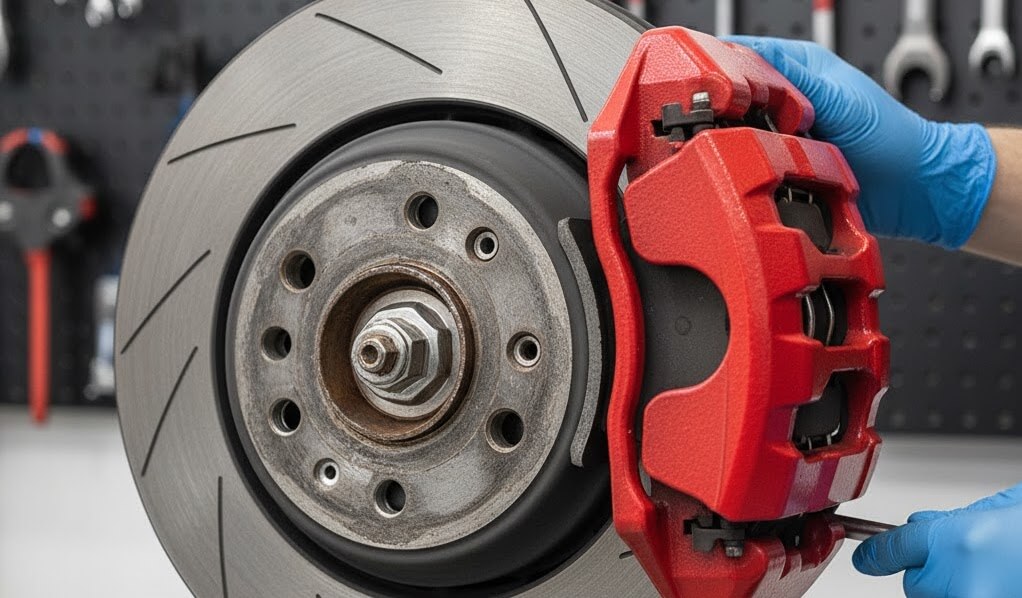
Driving a vehicle with a brake problem is not only unsettling; it’s outright dangerous. Half of all driving is governed by our ability to stop when needed. If you can’t stop reliably, you are endangering your own life, the lives of your passengers, and everyone else on the road. For this reason, you must give your brakes immediate attention the moment they show signs of deterioration. If you’ve been asking yourself, “What does it mean when my brakes…?” then keep reading. We’ll cover 5 of the most common brake problems drivers encounter and what can be done to fix them.
1. Squealing, Screeching, or Humming Noises
Brake noise of any kind is an alarm that something is wrong with your braking system.
Often, this high-pitched squeal is the simplest problem to fix: it’s a built-in “wear indicator” telling you it’s time for new brake pads. A simple brake pad replacement will solve the problem.
However, if the noise isn’t pad-related or sounds more like a grinding or humming, you’ll need a deeper inspection. Other causes include:

- General Rust & Corrosion: A basic inspection can check for caked-up dust and grime on the caliper and retaining components. These parts may need to be cleaned, lubricated, and replaced if worn.
- Rear Calipers or Drums: These may need to be checked and adjusted. An inspection will look for problems like grooves or improper wear. Parts with uneven wear or significant corrosion that can’t be removed should be replaced.
2. Pulsing Brake Pedal
If your brake pedal has a “heartbeat-like” pulsing sensation when you apply it, the problem is usually with the brake rotor (also called the disc).
This pulsing often means the rotor’s surface has become uneven. A “thickness variation test” can confirm if the rotor is no longer even throughout. When this happens, the rotors may need to be resurfaced (if they are thick enough) or, more commonly, replaced.
However, the rotors aren’t the only potential culprit:
- Wheel Hubs: If the rotors are fine, the wheel hubs could be the real issue. Rust and debris on the mounting pad can distort the rotor and cause pulsation.
- Uneven Wheel Lugs: If the lug nuts are tightened unevenly, it can warp the rotor’s seating. The wheel should be seated properly, and a torque wrench must be used to set the lugs to the manufacturer’s specification.
3. Excessive Brake Dust on Wheels
While a small amount of brake dust is normal, noticing thick, heavy layers of black dust on your wheels likely means you need brake service.
This excessive brake dust is corrosive because it’s not just “dust” – it’s a mixture of metal fibers from the rotor and adhesive material from the brake pad. This mixture is created when a failing pad begins to wear away the metal of the rotor itself.

This super-heated material adheres to your brake parts, wheels, and tires. Over time, this corrosive mixture can lead to rust and other forms of wear. This is a clear sign you should have your rotors and pads investigated by a professional.
4. Excessive or Rapid Brake Wear
Do you feel like you’re replacing your brakes every few years? While driving style, frequency, and environment greatly influence how often brakes should be changed, excessive wear can also be the product of other problems.
One of the most overlooked causes is old or dirty brake fluid.
Brake fluid should be clear or slightly amber, not brown or black. As brake fluid ages, it absorbs moisture and collects corrosion from brake lines and parts. These impurities in the fluid are like having pressurized sandpaper running through your delicate hydraulic braking system. Simply put, it causes a lot of problems the longer it remains.
Make sure your mechanic checks your brake fluid with every oil change. A brake fluid flush may be all you need to protect the life of your calipers, lines, and other components.
5. Car Pulling to One Side When Braking
This is one of the most serious symptoms. If you apply the brakes and your vehicle pulls heavily to one side, causing steering difficulties, it usually means one of the front brakes is not working. The “pull” you feel is the other brake doing the full stopping function all by itself.
There is no simple fix for this. It indicates a critical failure in the system, such as a seized caliper or a collapsed brake hose. A full brake system diagnostic is required to locate the exact point of failure.
Safety Warning: You should never drive a vehicle that is pulling to one side. It is extremely unsafe and requires immediate professional service
Don’t Ignore Your Common Brake Problems
From a simple squeak to a dangerous pull, your brakes communicate their health to you. Ignoring these signs can lead to more expensive repairs down the road and, more importantly, put your safety at risk.
If you are experiencing any of these brake problems, especially in the stop-and-go traffic of San Diego, don’t wait.
Are you having problems with your brakes? We provide comprehensive Brake Service and Inspections to keep you safe on the road. Give us a call at (858) 925-5359 or stop by our shop for an honest, ASE-certified mechanic’s opinion.
